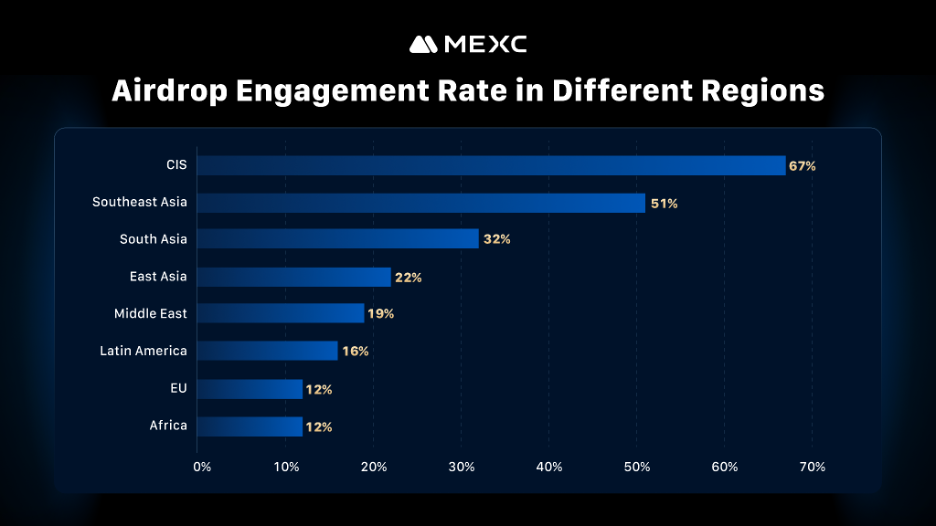Airdrops Drive 35% of New MEXC Users

Turns out, a new report from crypto exchange MEXC has shed light on something significant: more than one-third (a solid 35%!) of all their new user registrations were actually sparked by participation in airdrop campaigns. That’s a bigger driver than traditional ways of bringing in users, like referral programs, big marketing pushes, or even just folks signing up on their own.
How users are engaging with airdrops now compared to before
Historically, airdrops were initially designed as a really easy way for new people to step into the world of crypto, especially those who might not have bank accounts or live in places where financial access is limited. They worked by offering a free way to interact with blockchain projects and giving out financial rewards simply for completing basic tasks.
However, MEXC’s most recent report points to an interesting change in how users are engaging with these airdrop campaigns. It seems game-like features (gamified mechanics) and solutions designed specifically for mobile phones are increasingly influencing how users behave and boosting their participation in airdrop events.
Take the rise of the “tap-to-earn” trend, for instance, particularly popular within the Telegram ecosystem. It’s captured the attention of millions of users. These apps skillfully blend gamified elements and entertainment value, letting users earn points, rewards, and even ‘mine’ tokens right from their mobile phones using simple taps. This setup has really appealed to many users looking to potentially turn their time spent gaming or scrolling social media into some real-world gains.
The growing social buzz around tap-to-earn games like Hamster Combat, Yescoin, and Notcoin has certainly played a part in the significant jump witnessed in airdrop-driven registrations.
Thanks to the ease of access and straightforward requirements these apps offer, millions who previously had zero interest or experience in crypto have been drawn into participating in airdrop campaigns hosted on centralized exchanges (CEXs).
What users do *after* the airdrop
While it’s clear airdrops are great at getting people to sign up initially, for CEXs, the real test of an airdrop campaign’s success is whether those users actually stick around.
According to that same MEXC report, a significant 76% of users who first registered through an airdrop campaign don’t just disappear; they remain on the platform and continue to engage with other projects even after they’ve claimed their airdrop tokens.
Digging a bit deeper, the analysis showed that 18% of these airdrop participants turn into active traders, handling an average daily trading volume of over $58,000 – with some even hitting impressive figures as high as $31 million. Another 58% keep trading, but less frequently. However, about 24% decide to withdraw their funds and don’t continue trading activity.
Where in the world are airdrops most popular?
Looking at engagement across different regions, the report reveals that the Commonwealth of Independent States (CIS) region leads the pack by far. Here, an astonishing 67% of new users trace their registration back to airdrop participation.
The widespread popularity of Telegram and mobile-first digital experiences in the CIS region has really fostered a strong culture that embraces crypto. Following the CIS are Southeast Asia and South Asia, with 51% and 32% respectively. The higher levels of engagement in both these regions are often linked to limited access to traditional financial services.

In these areas, airdrops offer a free and decentralized way to access financial services without any upfront costs. They provide an efficient and affordable solution for things like international money transfers and payments across borders.
On the flip side, regions like Europe, Africa, and Latin America showed lower levels of airdrop participation, even though overall interest and adoption of crypto are quite strong there. What might be pulling users’ attention away in these regions? Perhaps the appeal of DeFi platforms, which often promise more attractive earning opportunities, or maybe even ‘token fatigue’ – that’s when users have joined tons of airdrop campaigns but haven’t really seen any noticeable value from the tokens they received.
“`html
Hey, did you know that according to a new report from crypto exchange MEXC, over a third (that’s 35%!) of all their brand new users actually joined because they participated in an airdrop? That’s right, airdrops are pulling in more new people than even popular methods like referral programs, marketing campaigns, or folks just finding the platform on their own.
How the game is changing for users during airdrops
Think back a bit: traditionally, airdrops were designed to be a super easy way for newcomers, especially those in regions with limited banking or financial access, to get a foot in the crypto door. They were a free pass, offering financial rewards for completing simple tasks and letting people engage with blockchain projects without needing any upfront investment.
But here’s where MEXC’s latest report gets interesting – it shows a shift in the whole dynamic of how users interact with airdrop campaigns now. Gamified elements and solutions built primarily for mobile phones are increasingly playing a big role in shaping user behavior and boosting participation.
Just look at the rise of the “tap-to-earn” craze, particularly taking off within the Telegram world; it’s grabbed the attention of millions. These apps are clever because they use game-like mechanics and actually offer entertainment, letting users earn points, rewards, and even ‘mine’ tokens using nothing but their mobile phone. This kind of system has really clicked with lots of users hoping to turn their time spent gaming or on social media into potential earnings.
The huge social popularity of tap-to-earn games like Hamster Combat, Yescoin, and Notcoin has certainly contributed to this impressive surge in airdrop-driven sign-ups.
Their straightforward accessibility and simple entry requirements have successfully drawn in millions of users who previously had absolutely no crypto interest or experience, encouraging them to jump into airdrop campaigns hosted on centralized exchanges (CEXs).
What happens *after* the airdrop is over?
While airdrops clearly rock at getting initial sign-ups, for CEXs, the true measure of success for any airdrop campaign is whether those users stick around.
Good news! According to the MEXC report, a solid 76% of users who originally registered via an airdrop campaign actually remain on the platform and keep engaging with other projects even after they’ve claimed their airdrop tokens.

Looking closer, the analysis revealed that 18% of these airdrop participants become quite active traders, averaging a daily trading volume of over $58,000 – and some even hitting figures as high as $31 million! Another 58% continue to trade occasionally, while 24% eventually withdraw their funds and stop trading on the platform.
A look at regional airdrop hot spots
When we break it down by region, the data shows the highest levels of engagement in airdrop campaigns are squarely in the CIS region, where a whopping 67% of new users came from participating in airdrops.
The massive popularity of Telegram and mobile-first experiences there has really helped cultivate a strong, crypto-friendly vibe in the area. Following behind are Southeast Asia and South Asia, with 51% and 32% respectively. The higher engagement levels in both these regions are heavily influenced by the limited access people might have to traditional financial services.

For folks in these regions, airdrops offer a free and accessible way to tap into financial services without any cost involved. They provide an efficient, cost-effective solution for things like sending money internationally or making payments across borders.
Curiously, Europe, Africa, and Latin America saw lower levels of airdrop participation, even though crypto interest and adoption are generally quite strong there. What might be the reason? Perhaps the rise of DeFi platforms, which can offer appealing and potentially more profitable earning chances, or maybe even ‘token fatigue’ among users who’ve tried many airdrops without seeing tangible value from the tokens they received – these factors might be drawing users’ focus away from traditional airdrop campaigns in these areas.











